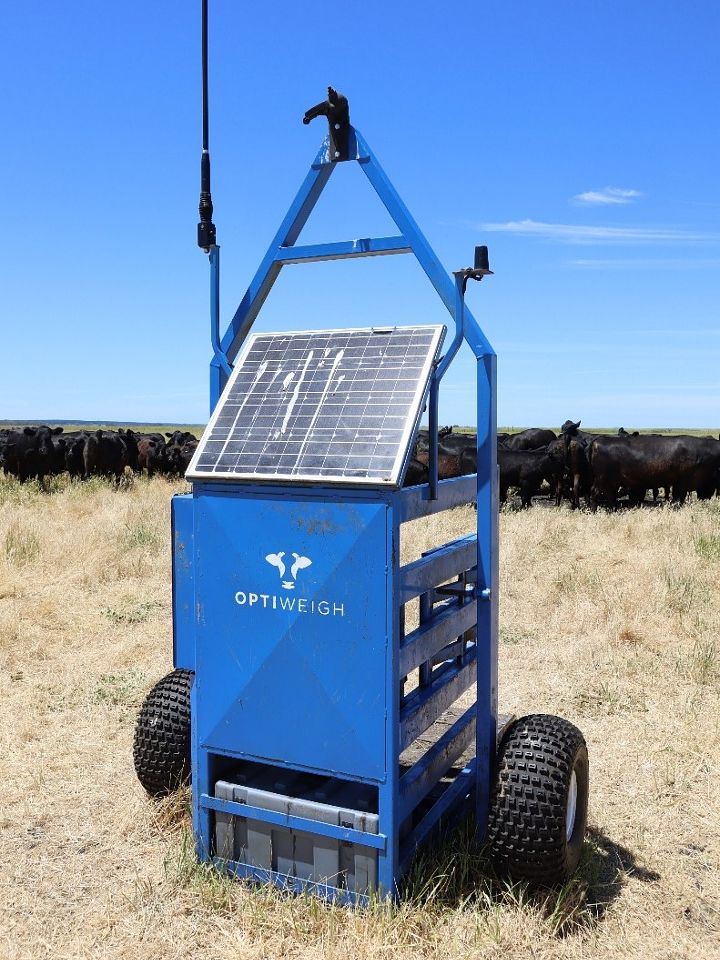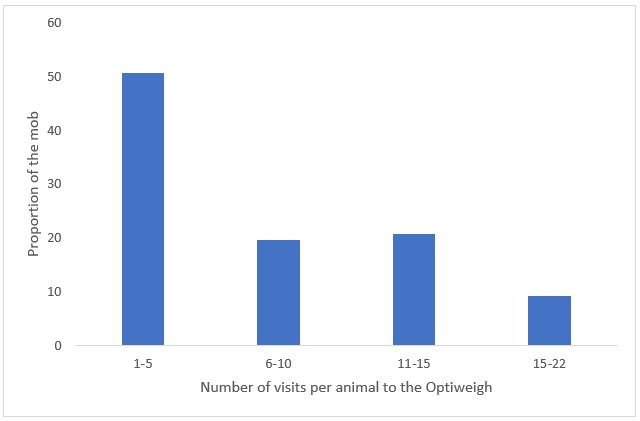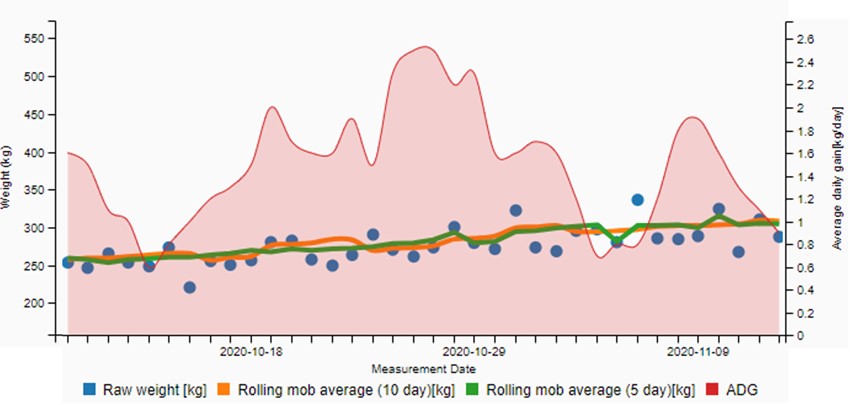In-paddock cattle weighing – Optiweigh
A mobile, automatic system for weighing cattle in-paddock.

Benefits
Optiweigh collects and monitors the liveweight of cattle in real-time without the cost, labour and liveweight loss associated with yarding livestock regularly.
The system is stress-free for animals and the farmer. The weighing unit can be moved around farm to meet your needs, such as monitoring different cattle varieties.
Heifer liveweights can be monitored to ensure feed budgeting is on track and they reach a suitable mating weight prior to joining. Steer weights are monitored to make sure they are gaining weight and that feed budgeting is on track, especially when pasture feed availability is low.
How it works
Optweigh enables completely mobile and automatic monitoring of livestock weight in-paddock.
With the use of an attractant, such as molasses or a mineral block, cattle step onto the Optiweigh with their front feet and their weight is measured. This data is used to determine the total liveweight of the animal.
Weights from the Optiweigh are well-correlated with conventional weighing. Weights can be recorded with or without a radio-frequency identification (RFID) tag.
You can monitor the average weight and average daily gain of the mob through the Optiweigh dashboard. Data is accessed from a mobile app, computer dashboard and daily email updates.
Optiweigh dashboard showing average weight, rolling average and average daily gain of heifers
Installation and power
Optiweigh is towed to the paddock where the mob of cattle is held, and then turned on for weighing.
Power is supplied through a solar panel and battery.
Connectivity requirements
3G or 4G coverage is required. Connection via satellite is also available.
Pricing model
Optiweigh has an upfront cost for the unit with ongoing data subscription fees.
Producer case study
Tom Gooden from Growth Farms Australia is based at Camperdown in Victoria and is using Optiweigh to monitor steer and heifer weights. It has allowed them to track steer liveweight gain to ensure they will meet forward contracts on time.
Their 40 heifers had an average weaning weight of 230kg in October and were expected to reach an average pre-mating weight of 330kg in June. The heifers' feed budget ensured they gained a minimum of 300g per day prior to joining. However, the grain utilisation was poor and Optiweigh indicated the heifers were maintaining condition, not gaining weight.
Tom was skeptical of the Optiweigh data and brought the heifers in to be yard weighed. The average weight displayed by Optiweigh was accurate and Tom altered the ration, moving the heifers onto a paddock with more pasture availability.
Throughout 240 days on feed, the farm staff would usually yard weigh the heifers 5 times. By using Optiweigh, yard weighing was reduced to 2 times.
Not all the heifers visited the Optiweigh while it was in the paddock. On average, 50% of the mob were weighed between 6 to 22 times during a 3-month period. This provides sufficient information on average mob performance to inform feeding and management decisions.
 Proportion of the mob that visited the Optiweigh between March and July
Proportion of the mob that visited the Optiweigh between March and July
The farm has low 3G connectivity, but it is adequate to transmit data on a daily basis.
Tom is saving on labour to weigh stock monthly and can objectively measure performance at any time. He believes the Optiweigh will pay for itself within a few years.
Tom advised Optiweigh users to monitor the attractant used. From his experience, molasses was the best to attract the cattle rather than salt, but experiences could differ.
Weight comparison
Weights taken with Optiweigh compared with similar weights measured in the yards:
Heifer ID | Yard weight | Optiweigh weight | Weight difference |
|---|---|---|---|
| R104 | 316 kg | 319 kg | 0.9% |
| R131 | 363 kg | 358 kg | -1.4% |
| R133 | 345 kg | 355 kg | 2.9% |
| R136 | 341 kg | 334 kg | -2.1% |
| R138 | 308 kg | 309 kg | 0.3% |
| R18 | 381 kg | 383 kg | 0.5% |
| R22 | 356 kg | 358 kg | 0.6% |
| R34 | 369 kg | 371 kg | 0.6% |
| R35 | 357 kg | 356 kg | -0.3% |
| R36 | 329 kg | 321 kg | -2.5% |
| R38 | 329 kg | 334 kg | 1.5% |
| R39 | 358 kg | 378 kg | 5.7% |
| R56 | 334 kg | 341 kg | 2.2% |
| R57 | 319 kg | 327 kg | 2.5% |
| R64 | 314 kg | 323 kg | 2.8% |
| R70 | 305 kg | 320 kg | 4.9% |
| R72 | 380 kg | 364 kg | -4.3% |
| R75 | 265 kg | 266 kg | 0.4% |
| Average ± standard error | 337 ± 7 | 340 ± 7 | 0.9 ± 0 |
Return on investment (ROI) estimate
The below table demonstrates 3 scenarios to compare the costs of:
- monitoring heifer weight by regular yard weighing only
- an undetected decrease in heifer weight with less frequent yard weighing
- monitoring heifer weight using Optiweigh and minimal yard weighing.
Estimated ROI is based on using Optiweigh to monitor a mob of 40 heifers over 8 months. If the average liveweight loss is detected early, the return on investment of using the Optiweigh is realised in the first year. If an issue is detected with Optiweigh, there will be a 136% return.
Costs and losses | 5 yard weighs | Undetected weight drop + | Using Optiweigh + |
|---|---|---|---|
| Mob liveweight loss from yard weighing1 | 840kg | 336kg | 336kg |
| Undetected mob liveweight loss | - | 2,000kg (50kg per head) | - |
| Labour cost of yard weighing2 | $1,250 | $500 | $500 |
| Motor vehicle cost3 | $36.00 | $3.60 | $3.60 |
| Cost of liveweight loss4 | $4,200 | $10,000 | $1,680 |
| Unborn calves from conception loss5 | - | 6 | - |
| Production loss from lowered conception rate6 | - | $13,500 | - |
| Total costs | $5,450 | $24,000 | $2,180 |
| Profit or loss | - | -$21,820 | $3,270 |
| Return on investment | - | - | 13% of costs recovered in the first year |
- Induction weight was 230kg with a target weight of 330kg over an 8-month period. Estimated liveweight loss of 1.5% of average body weight from yard weighing.
- Labour estimated based on $50 per hour for 2 people, at 2.5 hours each weighing event.
- Motor vehicle costs estimated at $0.72 per km for an average of 10km return trip.
- Costs based on $5 per kg.
- Estimated conception loss of 10%, from an expected 95% conception rate, caused by undetected liveweight loss.
- Estimated production based on loss of a steer sold at 450kg at $5 per kg.
The ROI is realised when weight loss is detected and can be immediately rectified. Utilising the Optiweigh over a larger number of cattle improves the ROI from what is described.
The Optiweigh can also track average daily gain to ensure cattle reach a target weight at the right time, further adding to the ROI.
The ROI excludes the Optiweigh costs (current as of February 2022):
- purchase price: $17,000 excluding GST
- ongoing data subscription costs: $240 per year.
Contact vendor
Bill Mitchell – Optiweigh
Phone: 0427 758 378
